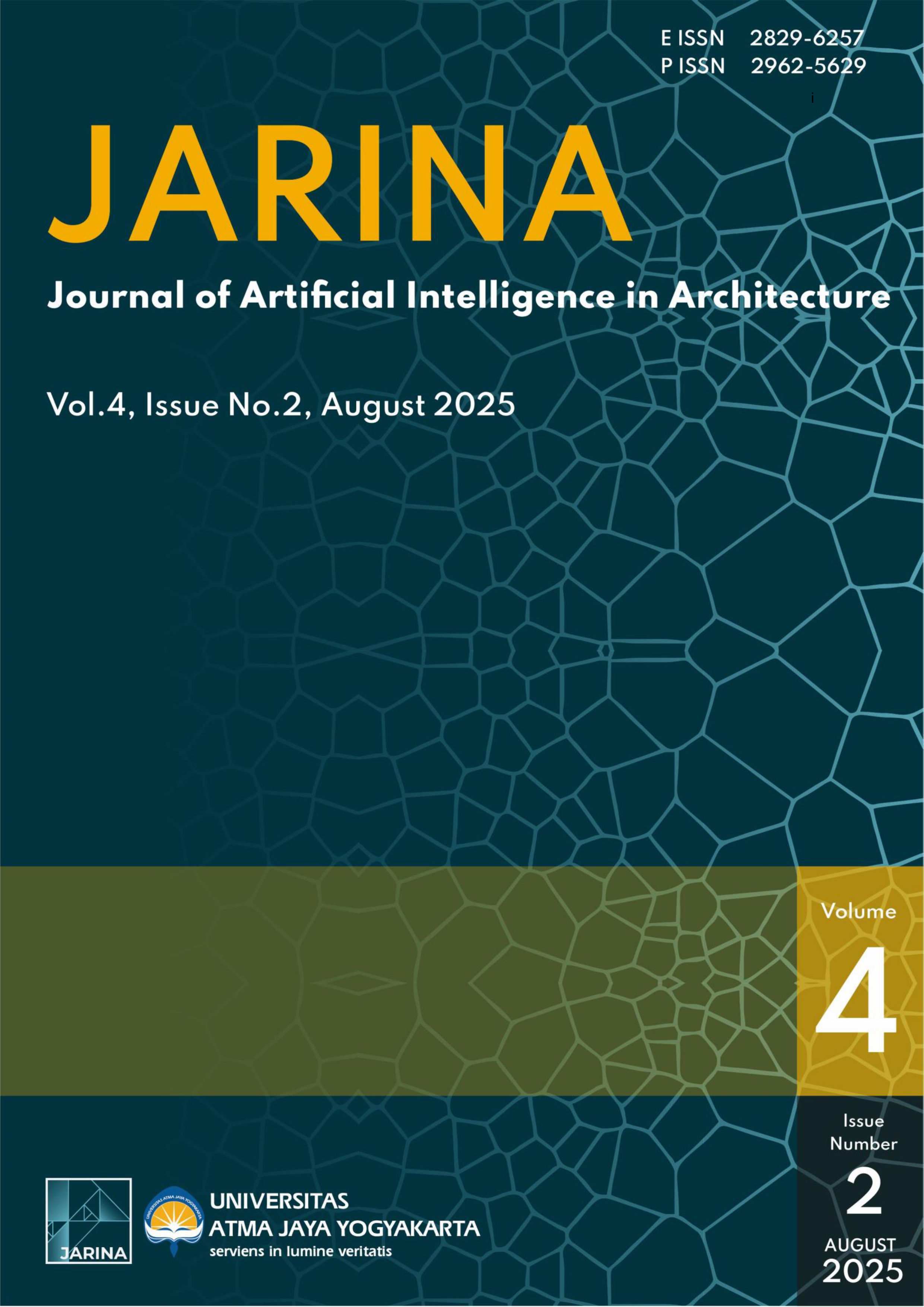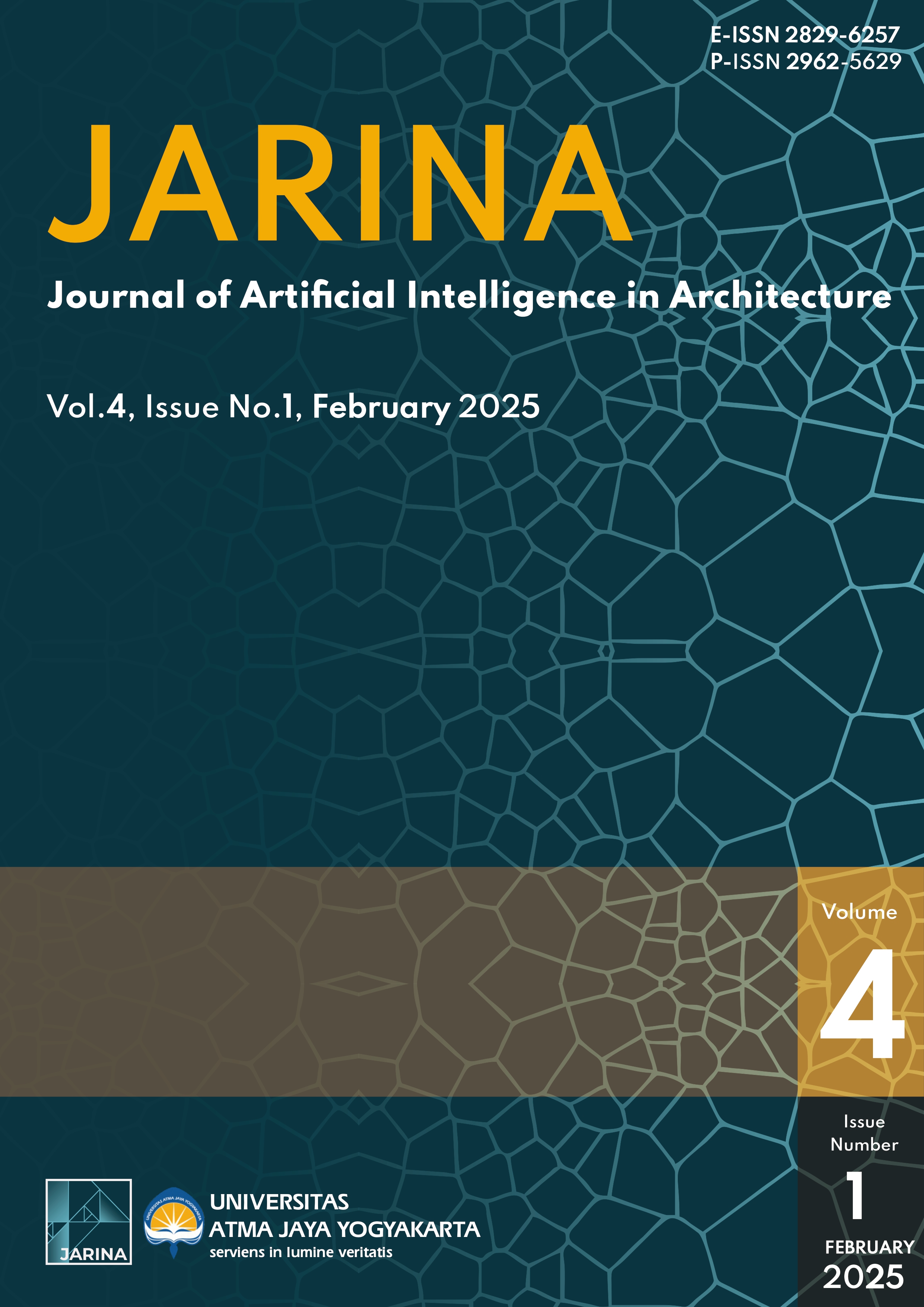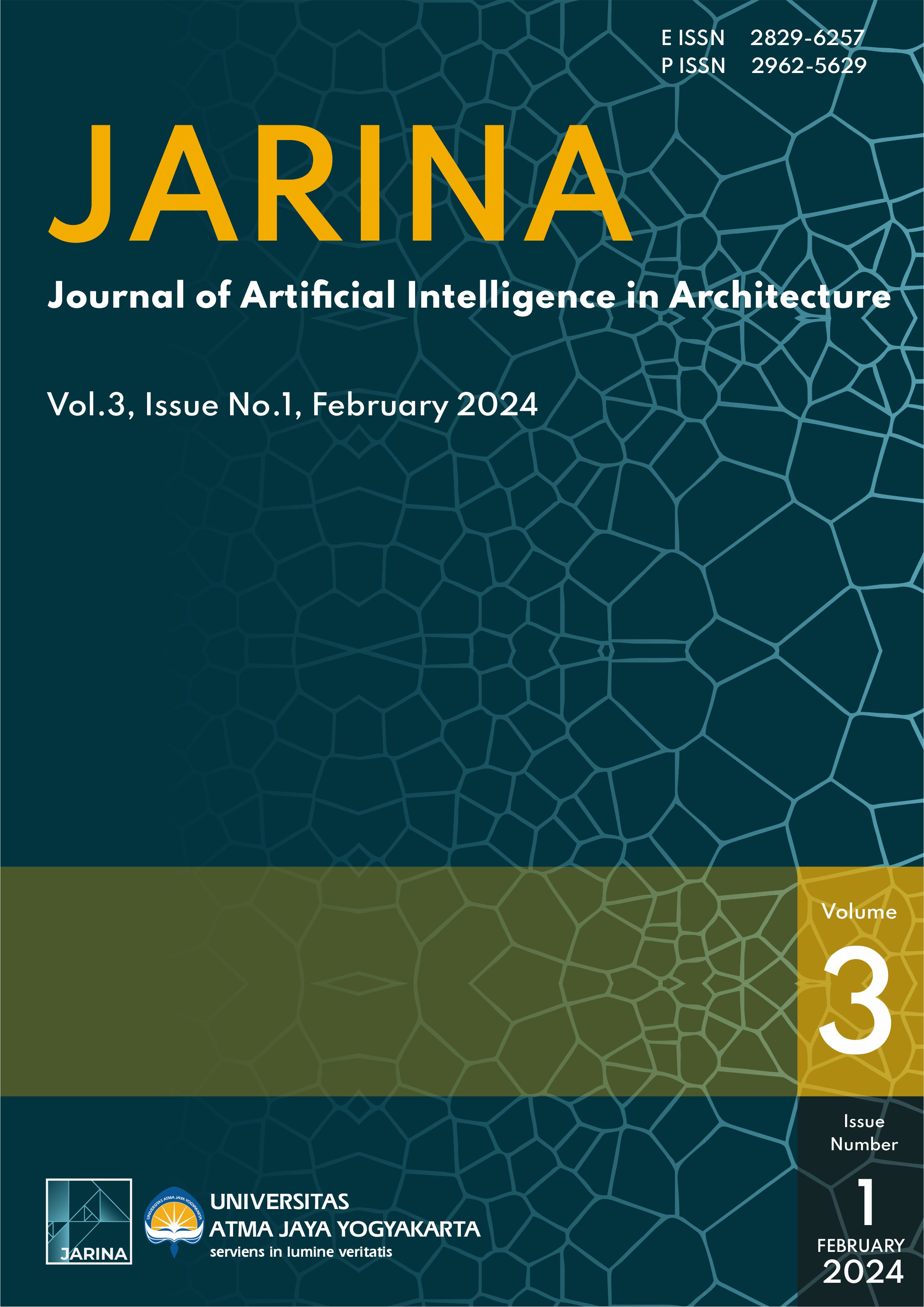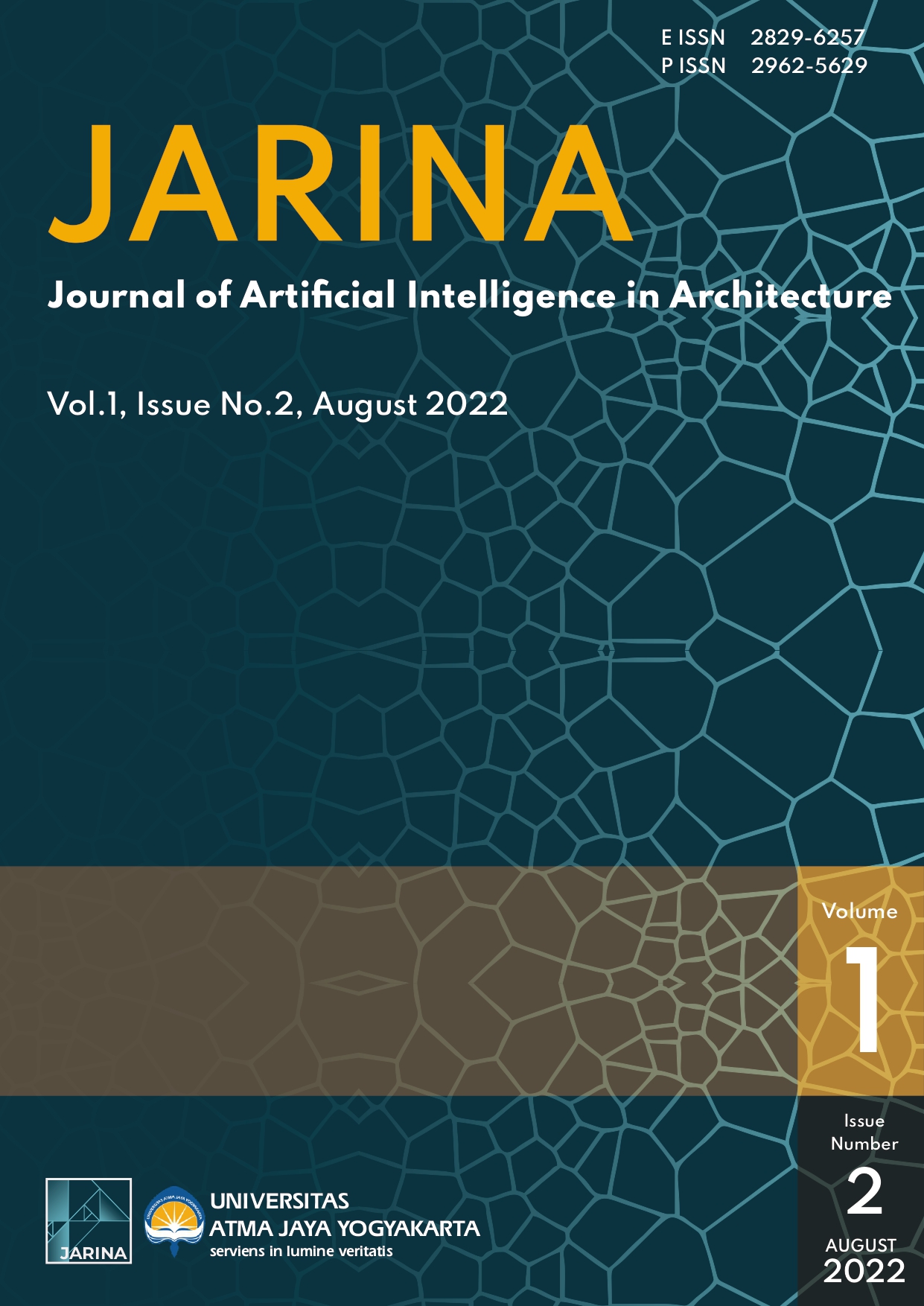Archives
-

Artificial Intelligence for Transformative Architecture: Integrating AR, Computational Design, and Sustainable Performance Strategies
Vol. 4 No. 2 (2025)Architecture stands at a turning point, where imagination meets cutting-edge technology. The new tools, including augmented reality, generative AI, environmental analysis, and computational simulations, are shaping today’s design and teaching practices. They are streamlining our workflows and opening fresh avenues for creative thought.
In this eighth issue of JARINA (Journal of Artificial Intelligence in Architecture), Volume 4, No. 2, we feature five insightful papers that capture this evolution. Among them: a case study of AR in architectural education using the Lego House, an exploration of text-to-image AI as a springboard for conceptual design, and a systematic review examining how children visually respond to city landmarks. We also present work on generative design to guide early-stage decision-making and a study on natural ventilation performance in Indonesian mosques.
Collectively, these contributions highlight a common theme: technology is acting as a spark for more inventive, inclusive, and sustainable architecture. As these digital tools advance, they are poised to redefine how we design spaces and how people experience and relate to them.
We are deeply grateful to every author, reviewer, and editorial team member whose dedication made this issue possible. We hope the ideas shared here will inspire new conversations, partnerships, and breakthroughs among our readers worldwide.
Khaerunnisa
EDITOR IN CHIEF
J A R I N A
Journal of Artificial Intelligence in Architecture
-

The AI-Driven Evolution: Transforming Architecture, Design, and Urban Spaces through Innovation and Immersive Technologies
Vol. 4 No. 1 (2025)In recent years, the field of artificial intelligence (AI) has witnessed remarkable advancements, significantly impacting various industries, including architecture. This collection of papers explores the deepening relationship between AI and architectural practices, examining how AI fundamentally reshapes the realms of design, education, urban planning, product development, and human perception. As AI becomes increasingly integrated into diverse disciplines, it presents both exciting opportunities and formidable challenges, potentially transforming our built environment in previously unimaginable ways.
The seventh issue of JARINA (Journal of Artificial Intelligence in Architecture), with the title “The AI-Driven Evolution: Transforming Architecture, Design, and Urban Spaces through Innovation and Immersive Technologies”, presents five papers that explore the integration of AI into research, design, and education within the architectural sphere. The first paper offers a comprehensive review of AI's origins and rapid evolution, with a particular focus on its active influence within the interior design industry. The second paper investigates the role of virtual reality (VR) in architectural education, highlighting how immersive VR technologies can potentially enhance learning experiences. The third paper delves into the incorporation of AI into Building Information Modeling (BIM), examining its transformative effects on architectural design studios by optimizing workflows, predicting design outcomes, and assisting in real-time decision-making, thereby altering the dynamics of the architectural design process. The fourth paper assesses the impact of shifts in transportation infrastructure on urban facades and architectural spaces, analyzing how these changes alter the perception and function of architectural environments. Lastly, the fifth paper explores the psychological and emotional connections with wooden product design, emphasizing the impact of design on human well-being. By applying neuro-architectural principles, this paper investigates how design elements can foster emotional responses in enhancing user experiences. These papers illustrate the multifaceted ways AI influences the architectural and design disciplines, providing a comprehensive perspective on its impact on creativity, education, urban environments, and human-centred design. As we continue to explore the vast potential of AI in architecture, it is evident that these technologies will play a crucial role in shaping the future of the built environment, influencing both the design process and our experiences of the spaces around us.
In light of this exploration, we invite researchers in digital art, informatics, neuroscience, architectural technology, building sciences, urban design, and related areas to contribute to JARINA. We hope that the papers presented in this issue will inspire and enrich our readers' understanding of architecture and digital technology. Lastly, we express our gratitude to all the authors and contributors involved in the publication of this seventh issue.
Khaerunnisa
EDITOR IN CHIEF
J A R I N A
Journal of Artificial Intelligence in Architecture
-

Artificial Intelligence for Architectural Alchemy: Fusing Human Creativity and AI Innovation in Design
Vol. 3 No. 2 (2024)AI's role in architecture has evolved significantly, moving from mere computational tools to complete sophisticated systems that, if appropriately utilised, may enhance creativity and efficiency during architectural design. This emerging interaction of AI and architecture brings an exciting yet unique relationship. AI can address intricate architectural design issues regardless of the scale, such as solving urban planning challenges and constructing opening designs for the architect. Then, the architect may interpret and modify the results according to their cognitive skills to bring those “AI dreams” into reality. Afterwards, those final products could, in turn, be utilised to enrich AI’s vocabulary as AI training materials and vice versa. This kind of intertwining interaction between architecture and AI capabilities is emerging as a recurring theme in many literatures. At its pinnacle, one of them introduces the term "architectural alchemy", where the synergy between AI and human intuition is crucial for maximising design potential in architecture.
Many scientists have conducted systematic reviews of AI applications in architecture, revealing a diverse array of interdisciplinary studies that underscore the potential of AI to revolutionise architectural practices. To unravel this trend, this sixth release of JARINA (Journal of Artificial Intelligence in Architecture) presents five papers emphasising comprehensive literature explorations about AI in architecture as follows. The first author conducted systematic article reviews to investigate the optimum utilisation of AI in supporting the interior design process. The second author reviewed a program based on agent-based AI, AnyLogic, to measure the efficiency of emergency access on evacuation routes. The third author examined several scientific journals about the application of neuroscience and AI in optimising biophilic architectural design. The fourth author evaluated the natural lighting performance of a house in Bandung to discover its effectiveness and potential future improvements. Then, the fifth author suggested that AI can be deployed to optimise the project’s workflow by selecting building materials efficiently. In conclusion, the intersection of AI and architecture is a dynamic field characterised by rapid advancements and ongoing debates about the balance of creativity and technology. As the literature reveals, AI enhances design efficiency and challenges traditional architectural narratives, prompting a re-evaluation of the architect's role in the digital age.
We express our gratitude to all the authors and parties involved in issuing this sixth issue of JARINA. For researchers worldwide, we kindly invite you to publish your remarkable works in digital art, informatics, neuroscience, technology, building sciences, urban design, architecture, and others in JARINA. Lastly, we hope our papers can inspire and enrich our readers' knowledge to stay informed with the latest advancements in architecture and digital technology.
Jackobus Ade Prasetya Seputra
EDITOR IN CHIEF
J A R I N A
Journal of Artificial Intelligence in Architecture
-

Artificial Intelligence for Architectural Evolution: From Virtual Pedagogy to Biodigital Tectonics and Beyond
Vol. 3 No. 1 (2024)AI (Artificial Intelligence) gradually becomes a new normal in society. As almost everyone has internet access, AI permeates nearly all aspects of life, from suggesting hobbies to performing tasks or studies. One of the challenges in our society is the abrupt integration of AI into education. Nowadays, more students are aware of the availability of free AI tools. Students are highly tempted to utilize AI since it provides easy shortcuts to solve their class problems, often without realizing that this new method needs sufficient knowledge to be used appropriately as a learning tool. Consequently, educators and regulators can't rely on old conservative educational methods. They should constantly be updated with the latest news of AI technology to be able to quickly respond, adapt, and adjust their teaching method to prevent AI's negative impacts on students' learning process.
Artificial Intelligence (AI) integration in education has been a subject of increasing interest and research in recent years. In general, this phenomenon of AI integration has shown encouraging results in improving student performance and supporting educators with better teaching methods and materials. These developments underscore the transformative potential of AI in reshaping educational practices across various disciplines, including architecture education, in the future. Therefore, it is crucial to consider the opportunities and threats that AI presents in the context of architecture education, which hopefully will be translated into curriculum development and pedagogical approaches in Indonesia.
To discuss those challenges, this fifth release of JARINA (Journal of Artificial Intelligence in Architecture) presents five papers about the implementation of AI in architecture and education. The first author introduces Virtual Reality (VR) technology to promote active learning systems in architecture education. The second author examines the current tectonic production capability of two popular AI image-generating tools, especially in picturing organic concepts. The third author investigates the impact of Generative Artificial Intelligence (GenAI) on digital literacy development and holistic competencies in architecture education. The fourth author explores the workflow of Building Information Modelling (BIM) and Computer Aided Design (CAD) in several construction projects to highlight their effectiveness and efficiency in the design process. Finally, the fifth author identifies the role of AI and other computational methods in conducting preliminary design research to enhance architectural quality and quantity. In conclusion, integrating AI in architecture and education holds significant promise for transforming pedagogical practices, improving learning outcomes, and shaping the future of the architectural design process. However, it is mandatory to critically evaluate the development of AI along with the "readiness" state of the users to ensure ethical, inclusive, and effective educational practices.
As a result of this, we invite all researchers who put their work in the fields of digital art, informatics, neuroscience, technology in architecture, building sciences, urban design, and others to join us in JARINA. We expect all the papers presented here will inspire and enrich our readers' knowledge of architecture and digital technology. Lastly, we thank all authors and parties involved in publishing this fifth issue.
Jackobus Ade Prasetya Seputra
Editor in Chief
JARINA
Journal of Artificial Intelligence in Architecture -

Artificial Intelligence for Enhancing Building Performance, Design, and Analysis: Innovations in Sustainable Architecture and Virtual Spaces
Vol. 2 No. 2 (2023)The Age of Artificial General Intelligence (AGI) is imminent, driven by the explosive rate of Artificial Intelligence (AI) advancement. Decades ago, scientists were anxious about how machines and their ability to learn and think will affect and shape the future of our civilization. Various responses and forewarnings were conveyed publicly, both scientifically and fictionally. Hollywood movies such as "Ex Machina," "Transcendence," "Westworld," as well as worldwide blockbusters "Star Trek," "Star Wars," "Terminator," and "Avengers," demonstrate their predictions of AI that manage to achieve "singularity" and trigger extreme living conditions, either as utopia or dystopia.
This trend has long been acknowledged in the field of architecture and design. Computer Aided Designs, as the foundation of the digital era in architecture, now begin to be installed with AI features capable of providing user feedback. As a result, computers are more than just operated for drawing and presenting projects. Instead, they can act as private assistants actively involved in the design process. Among the popular features are climate analysis, form-finding algorithms, innovative, collaborative platforms, AI-assisted imagery, data collector and organizer, narrative generator, and many other functions. Although today those features appear only to incorporate "narrow AI" specialized for their tasks, experts suggest that it will not take long before "strong AI" or AGI takes over the whole process of architectural practices.
To explore further in those trends, this fourth release of JARINA (Journal of Artificial Intelligence in Architecture) presents five authors to convey their ideas and findings. As a recap, the first author examines several window materials to reduce building energy consumption using EnergyPlus. The second author uses Autodesk Revit to evaluate several techniques to optimize daylight inside Islamic housing. The third author identifies the potential of the virtual world for the development of architecture. The fourth author formulates the popularity of several Indonesian cities using Google Trends regarding users' healing purposes. Then, the fifth author discusses how MidJourney, an AI-generated imagery tool, can be deployed for architectural practices.
We have high expectations that all of the papers here inspire us to fortify our knowledge, particularly about architecture and technology, for a better future. In addition, we also express our best gratitude to all of the authors and parties involved in publishing this fourth issue. Lastly, we sincerely invite all researchers on digital art, informatics, neuroscience, technology in architecture, building sciences, urban design, and other similar topics to join us in JARINA.
Jackobus Ade Prasetya Seputra
EDITOR IN CHIEF
J A R I N A
Journal of Artificial Intelligence in Architecture
-

Artificial Intelligence for Design, Sustainability, and Mental Health: Exploring New Frontiers
Vol. 2 No. 1 (2023)We are entering a post-pandemic era where human civilization experiences a new, different way of life. During the last pandemic quarantines, technology has been becoming our backbone to overcome the hardships of physical restrictions. As result, digital technology has been blossoming and advancing at an exceptional rate to facilitate our needs in those dire situations. Since then, most of our daily services such as healthcare, food, entertainment, education, government affairs, and many other services have shifted their business orientation to digital technology. This trend continues and culminates at the end of 2022 with the emergence of AI (Artificial Intelligence) chatbots such as Chat GPT and Bard Google AI. Those inventions, according to experts, then are expected to permanently become a part of life and, in turn, might drastically shape our community in every aspect of life, including architecture.
Prior to the pandemic era, since the early 21st century, architecture has already been influenced by the rise of Industrial Revolution 4.0 with the massive inclusion of big data, cloud computing, robotics, artificial intelligence, cybernetics, 3D printing, as well as other forms of design optimization and collaboration. It is interesting to observe how those technologies keep evolving according to dynamic societal trends, such as the integration of AI in the architectural context. To accommodate those issues, this third release of JARINA (Journal of Artificial Intelligence in Architecture) facilitates five authors to present their remarkable research and findings. As an overview, the first author implements a biomimetic approach to figure out the design of an energy-efficient adaptive photovoltaic facade. The second author examines a riverside settlement using simulation modeling techniques to achieve sustainability. The third author develops a therapy room with a neuroarchitecture approach to effectively help people with mental disorders. The fourth author discusses about the presence of artificial consciousness as a continuation of AI inside robots and its implication in architecture. Then, the fifth author presents a review and prospective utilization of AI image generators in the architectural context.
In addition to those papers, we sincerely invite other researchers on digital art, informatics, neuroscience, technology in architecture, building sciences, urban design, and other related topics to join us in JARINA.
We have high expectations that all of the papers in this second issue would inspire our readers to develop architecture and technology for a better future. Lastly, we would like to express our appreciation to all of the authors and parties who were involved in publishing this third issue.
Jackobus Ade Prasetya Seputra
EDITOR IN CHIEF
J A R I N A
Journal of Artificial Intelligence in Architecture


















